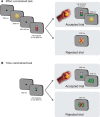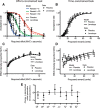Dopamine Manipulation Affects Response Vigor Independently of Opportunity Cost
- PMID: 27629704
- PMCID: PMC6601940
- DOI: 10.1523/JNEUROSCI.4467-15.2016
Dopamine Manipulation Affects Response Vigor Independently of Opportunity Cost
Abstract
Dopamine is known to be involved in regulating effort investment in relation to reward, and the disruption of this mechanism is thought to be central in some pathological situations such as Parkinson's disease, addiction, and depression. According to an influential model, dopamine plays this role by encoding the opportunity cost, i.e., the average value of forfeited actions, which is an important parameter to take into account when making decisions about which action to undertake and how fast to execute it. We tested this hypothesis by asking healthy human participants to perform two effort-based decision-making tasks, following either placebo or levodopa intake in a double blind within-subject protocol. In the effort-constrained task, there was a trade-off between the amount of force exerted and the time spent in executing the task, such that investing more effort decreased the opportunity cost. In the time-constrained task, the effort duration was constant, but exerting more force allowed the subject to earn more substantial reward instead of saving time. Contrary to the model predictions, we found that levodopa caused an increase in the force exerted only in the time-constrained task, in which there was no trade-off between effort and opportunity cost. In addition, a computational model showed that dopamine manipulation left the opportunity cost factor unaffected but altered the ratio between the effort cost and reinforcement value. These findings suggest that dopamine does not represent the opportunity cost but rather modulates how much effort a given reward is worth.
Significance statement: Dopamine has been proposed in a prevalent theory to signal the average reward rate, used to estimate the cost of investing time in an action, also referred to as opportunity cost. We contrasted the effect of dopamine manipulation in healthy participants in two tasks, in which increasing response vigor (i.e., the amount of effort invested in an action) allowed either to save time or to earn more reward. We found that levodopa-a synthetic precursor of dopamine-increases response vigor only in the latter situation, demonstrating that, rather than the opportunity cost, dopamine is involved in computing the expected value of effort.
Keywords: computational model; decision making; dopamine; effort-based decision making; psychopharmacology.
Copyright © 2016 the authors 0270-6474/16/369516-10$15.00/0.
Conflict of interest statement
The authors declare no conflict of interest.
Figures






References
-
- Berridge KC. The debate over dopamine's role in reward: the case for incentive salience. Psychopharmacology. 2007;191:391–431. - PubMed
Publication types
MeSH terms
Substances
LinkOut - more resources
Full Text Sources
Other Literature Sources
